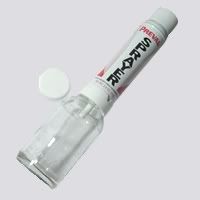I moderate at a home theater forum and my area of expertise is with projectors and screens, specifically high quality DIY screens.
Texture is something people don't want with screens either, and many screen options are with certain paints.
First thing is you want a good quality paint. They cover better and smooth out better too. Some of the better brands are PPG, Benjamin Moore, Valspar Signature Series, and Sherwin Williams. Of course that isn't a complete list, but you want to stay away from cheap paints like the Walmart house brand and things like that.
Foam rollers work but can be tricky for some people. You can also look for a 3/16th nap roller cover. Don't over look the actual roller itself though. Most people use rollers that come in those disposable painter's kits that include 1/4" nap or larger roller covers, a pan, and the roller. A good roller is firmer and helps provide a more even pressure across the cover and doesn't flex as much. This helps with roller marks.
One thing a lot of people do when it comes to screens is to add water to the paint. You can buy commercial products, but water will work just fine. You don't want to add too much, just enough to thin the paint out some to a more 'soupy' consistency. It doesn't change the color of the paint at all. When the water evaporates, what is left is a thinner, smoother layer of paint with very little texture. Don't roll with too much paint on the roller because then you will have a tendacy for runs and roller marks. Also don't dry roll. Apply a light but even/steady pressure and don't push down to get more paint out of the roller. If you hear 'thp thp thp thp' as you are rolling, you're most likely dry rolling and that sound is paint being pulled back from the surface to the roller, and that causes texture issues.
Also have a piece of scrap around. When you load up the roller, do a light roll on the scrap to remove any excess paint. I also do this with the ends of the rollers. When you have a lot of paint on the ends of the roller it tends to go down thicker and creates a roller line.
Probably one of the biggest reasons for texture is that a lot of people over roll and end up 'dry rolling', or they go over areas where the paint itself already started to dry. This causes the paint to start lifting from the surface as the roller passes over it and causes a lot of texture.
Another option is spraying. You don't have to have a compressor and commercial rig to spray, nor do you even need something like a Wagner. Most paint store carry these...

The base unit is around $5 and includes the reusable glass jar and one power cell. The power cells are around $3-4 each depending on where you get them. If you can use a spray can and paint without any runs, you can use the Preval! Compared to rolling, there is virtually no texture. It is comparable to the same texture you see with laminates. The Preval also does a very good job at spraying poly too. I actually sprayed a 100" diagonal screen with one of these before, so it can work for large areas, but practice some first.
Practice is the key though whether you are rolling or spraying. Try rolling with some water added on a piece of scrap wood and get used to the thinner paint and see how it works out. Once you feel comfortable, then you can tackle the cab itself and get a super smooth finish. If you want it to be a little more durable, you can add a coat of poly then. Some people don't want a high gloss finish, some may. For those that don't, Behr makes a Matte poly that is found in Home Depot, but it's not with the other poly's, it's in the Faux Finish section with the other Behr Faux Finish products. Just an FYI... a matte finish is the same as most laminates and LPL melamine boards have... so it would be the right sheen as compared to a commercial arcade cab in most cases.
Trust me on this, these tips really do work and can save a lot of time sanding down a rough looking texture that just screams 'I rolled with house paint'. A lot of texture is really bad when it comes to projection screens, so this is something we've had to deal with and spent a lot of time overcoming.




 Home
Home Help
Help Search
Search Login
Login Register
Register
 Send this topic
Send this topic Print
Print



